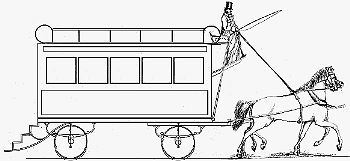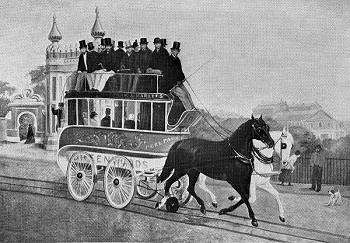 This is a side view of Curtis's tram extracted from GB patent 1071 of 1856 and shows its bus origins.
This is a side view of Curtis's tram extracted from GB patent 1071 of 1856 and shows its bus origins.
|
Horse Trams on Rail and Road
By John Prentice |
Some of the earliest pioneers of horse trams perceived the best solution for road transport as some form of tram that could leave the tracks when necessary. Here are two of the British ones. Neither of these looked like the horse trams that we know, which largely originate from the American style adopted by John Stephenson. Instead they resemble the two-horse buses of the day, which followed the designs of earlier stage coaches.
In 1853 Alphonse Loubat, a Frenchman who had worked for a time in New York and seen the streetcars there, imported two Stephenson horse trams into France and demonstrated them in Paris and in 1854 a public service commenced using larger double deck vehicles. These cars were "de-railable", that is if they met with an obstacle on the tracks, they would be pulled off the rails and manoeuvred around the obstruction. If fact after 1866 they continued beyond their rail terminus by being fitted with road wheels in place of their flanged ones.
William Joseph Curtis was at the time of his tram patent petition in 1856, described as a Civil Engineer resident at Sebbon Street, Islington, London. He had earlier designed a form of gripper for cable railways. In 1855 he visited Paris and saw Loubat's line, concluding that if this could be better mechanised then it would be ideal for use in Britain. George Francis Train is usually credited with bringing trams to Britain but this is not correct. He may have built the first tramway, that in Birkenhead which opened on 7th May 1860, but Curtis had patented his tram in 1856 and supplied one for operation in Liverpool in March 1859, a whole year earlier. It is also thought that in 1860 Curtis demonstrated his car, which was called "Enterprise", in Liverpool Road, Islington, London, but this was almost certainly in its on-road mode. However, it did operate for short periods in 1861 on the tracks of two of George Train's London tramways, those in Bayswater Road and in Kennington Road.
 This is a side view of Curtis's tram extracted from GB patent 1071 of 1856 and shows its bus origins.
This is a side view of Curtis's tram extracted from GB patent 1071 of 1856 and shows its bus origins.
In Liverpool, the tracks that Curtis used were those for the railway goods traffic of the Mersey Docks and Harbour Board, which were in the road and followed the same route as the popular "Line of Docks" bus service. Curtis did not operate the service himself but they were run initially by a local bus operator, either Gates and Dolby or William and Daniel Busby, both companies later working the line with "patent omnibuses". However by early 1860 Curtis was complaining that the bus operators, despite having written contracts to work his patent, had pirated the idea and produced bad copies of his invention. At the same time the Mersey Docks and Harbour Board started to ask for payments for the use of their rails, until then free of charge, to which the companies would not agree and thus the rail service ceased later that year.
So to the tram itself. This was covered by GB patent number 1071 dated 7th May 1856 and titled "Improvements in Carriages to Run on Rail or Tram Ways and Common Roads". To enable the car to run on both rails and the road, the wheels had retractable flanges. The axles of the car were static with the wheels revolving freely on them. A disc forming the flanges also ran free but revolved on an eccentric section of the axles, this eccentric being offset 1.5", the same depth of the flanges. At the end of the axles and keyed to them were clutches which would temporarily join the wheels to the axles. A lever, connected to the clutches by cranks and operated by the driver while the car was in motion, caused the clutches to engage and the axle to turn through 180 degrees, limited by a ratchet device. Due to the eccentrics, this would cause the flanges to be raised above the track. A repeat pull of the lever would repeat the action and lower the flanges again. No effort was required by the driver as the work was done by the motion of the car pulled by the two horses. In this way the flanges could be withdrawn and the tram could easily leave the track and be steered around any obstruction or avoid goods traffic which might be on the line.
The horse bus services in Manchester had been operated by the Greenwood family since 1824. The brother-in-law of John Greenwood junior, son of the founder, was one John Haworth of Thorncliffe, Old Trafford, Manchester. In 1860 the company wanted to try tramways and a visit was made to G.F.Train's Birkenhead line, but they were uncertain about all the problems they had heard of in connection with Train's step rail. As a result Haworth created his "Patent Perambulating Principle" and Greenwoods sought permission for a line from Pendleton (north-west of Manchester) via Salford to Market Street Manchester although in the event although the Pendleton Turnpike Trustees and Salford Council agreed, Manchester Council did not so the line terminated at the Salford/Manchester boundary in the middle of Albert Bridge, New Bailey Street. The tramway began service in September 1861 and continued in use until 1872 by which time Greenwoods and others had formed the Manchester Carriage Co. Ltd. and conventional tramways were being considered.
 Haworth's "Patent Perambulating Principle" road-rail horse bus operated in Salford between 1861 and 1872. From an 1872 painting by H. Calvert in Salford City Art Gallery.
Haworth's "Patent Perambulating Principle" road-rail horse bus operated in Salford between 1861 and 1872. From an 1872 painting by H. Calvert in Salford City Art Gallery.
Haworth's idea was covered by GB patent number 2326 dated 25th September 1860 and titled "Improvements in Tramways for Streets and Ordinary Roads and in Carriages for Running thereon". The Greenwood cars were in fact two-horse buses to which Haworth's device was added. The system was for use on straight or nearly straight roads. The rails were of a 'T' section laid level with the road surface on longitudinal wooden sleepers, with the web of the rail recessed into the timber. The gauge is unknown but was devised so as to match the axle length of the horse buses, so must have been close to standard gauge. Between the running rails was a third rail laid in a similar manner. In this case it had a centre groove. The cars were fitted with a fifth wheel which had a centre flange and which would engage with the grooved rail and thus steer the car keeping the running wheels on the rails. The driver held down a foot treadle and a system of levers tensioned against a spring pressed the guide wheel down into the grooved rail. At termini or when the car was required to turn corners or avoid obstructions the driver took his foot off the treadle and the spring would raise the guide wheel clear of the track. The patent also shows an alternative method of operation whereby the guide wheel was held to the rail by its own weight and was connected to a foot pedal by a chain instead of levers, the driver pressing the pedal to raise the guide wheel which could then be latched in the up position. This method is also that shown in a diagram in the Illustrated London News dated 16th November 1861. It is not certain which method was actually used, possibly both.